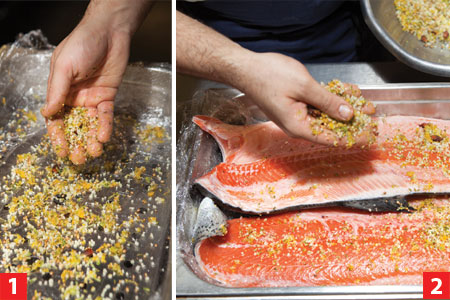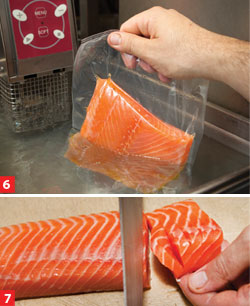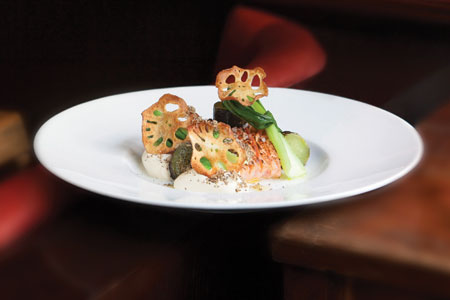Chef masterclass – Cured smoked salmon, by Paul Hood
Paul Hood's cured smoked salmon at the Social Eating House brings traditional smokehouse techniques right up to date. Michael Raffael reports
For the traditional smoker, the process produced the end result, but smoking now may be one of several steps leading up to a finished dish. They may experiment with the cure: dry or brine, or they can vary its flavour, adding citrus or spicy notes. For the smoking itself, there's an armoury of different woods, and the intensity of their aroma can be adjusted with time and temperature.
With hot smoking, the objective is to cook the raw product, but cold smoking doesn't cook food - it just changes its texture. It can dry out a product too - how much depends on the recipe.
A typical side of smoked salmon may lose 16% to 18% of its weight after processing.
Curing
Social Eating House buys organic Shetland salmon from supplier H Forman & Son. It receives untrimmed sides from 6kg fish. Each side yields 14 or more 70g portions.
The 'collars' - the curved bone around the gills - are intact. None of the fins have been trimmed.
The kitchen usually prepares a four-side batch. Ingredients here are for two sides.
Ingredients
- 200g rock salt
- 40g sugar
- Zest of 4 lemons (microplaned)
- Zest of 4 limes (microplaned)
- Zest of four oranges (microplaned)
- 10g fennel seeds (toasted)
- 10g coriander seeds (toasted)
- 10g mustard seeds (toasted)
- 1½ star anise
- 2 sides of salmon
Line with film a baking tray large enough to take the fillets. Combine all the ingredients for the cure and sprinkle a third over the film (1).
Lay the two salmon sides skin-side down and head to tail on the film and rub the rest of the cure over the flesh (2).
Cover the fish with a second layer of film and cure for 15 hours in the fridge at less than 5ºC.
After the time is up, quickly rinse the sides under cold running water and pat dry (3).
Cold smoking
Like several London restaurateurs, chef Paul Hood uses a Bradley Digital Smoker (his is a bespoke glass-fronted one, but the equipment is the same). This controls both the temperature and the amount of smoke in the cabinet by feeding briquettes onto a hotplate every 20 minutes to keep the temperature constant.
The salmon sides hang from tenters in the top of the smoking chamber.
To prepare a side, lay it flesh-side up on the surface. Make a hole with a skewer just below the collar bone - sometimes referred to as the shoulder - near the pectoral fin.
Thread a doubled length of string through the hole.
Make a second hole through the skin near the collar bone at the base of the side and thread the doubled string through it.
Tie the two ends of string together to form a loop, and hang the side from the tenter.
Cold-smoke the side for four to five hours at 30ºC. The time will vary according to taste, the condition of the fish and its weight.
Note The smoker is designed to drop spent briquettes into a bowl at the base of the cabinet. Hood suggests putting ice cubes in the cabinet to help keep the temperature constant and create a little moisture so the fish's surface won't dry out.
First trim
Lay the smoked salmon skin-side down on the work surface. Remove the collar and pectoral fin and the dorsal fin - the one along the edge of the backbone.
Take the skin off the fillet in the classic way, starting at the tail end (4). Slide a sharp, flexible-bladed knife under the creamy covered membrane over the
ribcage and belly (5). Pare it away and remove the long rib-bones at the same time. Trim the edges to give a neat finish to the side. Pin-bone the small bones running down the centre of the fillet.
Divide the fillet into three even-sized blocks, weighing about 400g each. Put each one into a separate vacuum pouch with about two tablespoons of olive oil and seal and chill. Before the second trim, drop the pouches into a water bath at 40ºC for five minutes (6).
Second trim and portioning Repeat this process for each vacuum pack. Take the piece of fillet from the pouch and pat dry with a clean J-cloth. Divide the fillet by cutting through the centre where the pin-bones were. Trim any dark flesh. You should now have two perfect salmon pavés, one thicker and the other broader.
The thicker piece should yield three starter portions. The thinner piece should give two portions and a little left over.
The aim is to make open concertina-like portions from each salmon pavé. Cut vertically across the flesh at about 1cm intervals without cutting all the way through. After four cuts, make the fifth one right through (7).
Social Eating House budgets for 14 portions from the three pouches.
Costing
The cost per fish from Forman and Field for two sides minus head and backbone is approximately £50.
On the menu, 'Cured smoked salmon, miso crème fraÁ®che, BBQ cucumber and truffle' sells for £12.50.
Cost price per portion is £2.90 and profit is £9.60, making a 76% gross profit.
Cured smoked salmon, miso crème fraÁ®che, BBQ cucumber and truffle
Serves one
- 1 x 70g prepared smoked salmon fillet
- Olive oil
- Lemon juice
- Maldon salt
- 2 quenelles of miso crème fraÁ®che (see box)
- 3 compressed cucumber discs (see box)
- 3 deep-fried lotus root crisps
- 3 blanched pak choi leaves
- Grated black truffle
Brush the salmon with oil. Fire a blowtorch at it until the surface has a slightly charred appearance (8). Squeeze over lemon juice and sprinkle with
sea salt. Arrange on the plate.
Serve with the quenelles, cucumber, lotus root crisps, pak choi and black truffle (which kind will depend on season, cost and availability).
Finish with a little olive oil.
Accompaniments
Miso crème fraÁ®che
Use an English brand of crème fraÁ®che such as Blackmore Vale, which has a higher butterfat content. Hang 650g of crème fraÁ®che overnight in a muslin bag so
the excess moisture drains away.
Whisk the crème fraÁ®che with 75g light miso paste, 10ml white truffle oil, lemon juice and seasoning. Shape the quenelles to order with a dessert spoon. Makes
enough for 15 portions.
Compressed cucumber
Use baby cucumbers, such as those found in Turkish or Middle Eastern shops. Top and tail the cucumbers and vacuum pack them individually with 5g sugar, 5g salt and a tablespoon of lemon juice.
Seal on full vacuum for five minutes to compress. Take them out of the pouches, drain and dry, and slice into 1cm-thick rings. Colour them with a blowtorch.
Just before service, dress them with this sweet and spicy pickling liquor.
Pickling liquor for cucumber
- 250ml muscatel vinegar
- 200ml white wine vinegar
- 200g caster sugar
- 2 star anise
- 2 cinnamon sticks
- 6 cloves
- 2tsp mustard seeds
Heat the vinegars and add the sugar to dissolve. Add the spices and infuse. Deep-fried lotus root crisps Peel and slice them as finely as possible with a Japanese mandolin. Deep-fry until crisp at 160ºC and drain on absorbent paper.
Blanched pak choi
Separate the leaves and blanch them in boiling, salted water until just wilted.
Basic guidelines for cold smoking
Paul Hood's method is specific to his recipe and neither the cure nor the smoking time is suited to traditional smoked salmon. However, it relies on principles that are commonly accepted as good practice. The sides have a smooth appearance, undamaged by cuts in the flesh. Don't accept any bruising on the surface. Any blood left on the fillet turns black during smoking. Fish farmed in a more extensive way and grown more slowly have a firmer texture and taste better. They are also more environmentally friendly.
Dry curing causes weight loss, as does the smoking. Commercially, this can be about 18%. If the aim is merely to impart flavour, the loss will be much less.
It is possible to smoke any ingredient, but there is a general consensus that raw materials with an oily or fatty content absorb flavour better and dry out less.
For food hygiene reasons, ensure there is no risk of cross-contamination between the salmon and other ingredients. Most chefs don't associate fish with food
poisoning, but it can be contaminated.
















